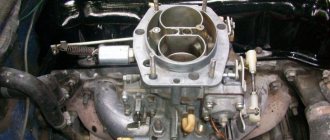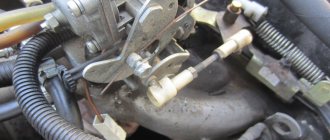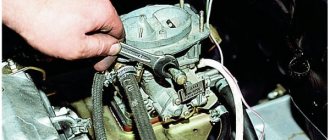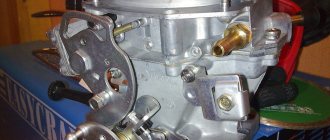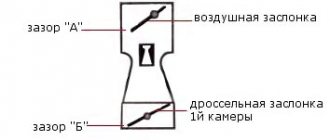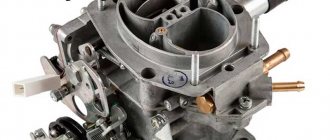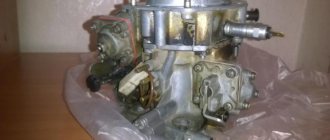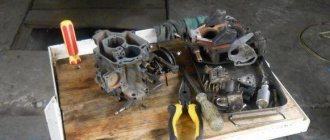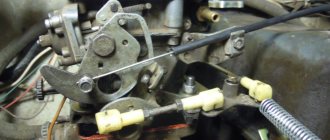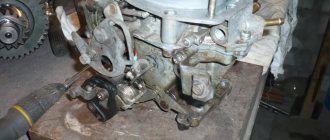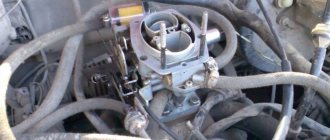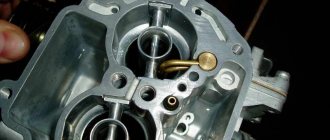For 30 years, while classic rear-wheel drive VAZ models were produced, their design, in contrast to style and design, was virtually unchanged by the manufacturer. Therefore, owners are trying to modernize the car themselves - introducing various components from imported cars or more technologically advanced VAZ models.
For example, many owners do not like the way Ozone and Weber carburetors work, which are not capable of providing acceptable acceleration dynamics, uniform acceleration, and acceptable fuel consumption. Despite the fact that all this is already in Solex. That is why most car owners strive to install a licensed French Solex on their classics.
"Ozone" and "Weber" under certain road conditions excessively leaned the fuel mixture. This happened because the float moved in the float chamber when sharply entering a turn or climbing a steep mountain. Solexes do not have such a disadvantage - they are equipped with two-section float chambers, paired floats that move in other planes. The Solex device is more modern and advanced.
Which Solex to choose
Units produced by Dimitrovgradsky differ mainly in the geometry of the jets. There is a difference in the diameters of the diffusers, as well as in the size and design of the air jets. The cam profile also differs.
However, without any unpleasant consequences or modifications, absolutely any Solex from the entire series can be installed on a car for which the carburetor was never made. Many models and modifications of these carburetors were produced - they were equipped with VAZ-08, 09, AZLK-21412, ZAZ-1102. There are “Solex” for VAZ-2104, 05, 07. This all means that absolutely any unit from the mentioned line can be installed on rear-wheel drive VAZs without modifications or almost without them.
The result of tuning depends on the choice of a particular Solex. But in any case, the engine’s traction will improve and the car will accelerate smoothly. To save money, it is worth choosing the Solex modification on the Tavria - this is DAAZ-2181. If you need increased acceleration dynamics, then select DAAZ-21073. It features diffusers of larger diameter. This carburetor was created for engines with a displacement of 1.7, and after installing this Solex on a classic, you should prepare for high fuel consumption.
Solex models 2108, 21083, 21051-30 are considered by motorists to be the golden mean. The units are capable of providing better dynamic characteristics and lower fuel consumption when comparing their characteristics with Ozone.
Table of fuel jets for Solex carburetor 21083
Repair and cleaning of the VAZ 2109 carburetor
In the process of throttling the carburetor, one can observe an unstable composition of the fuel mixture over time in the working charges; there is no cycle identity. This has a significant impact on the composition of exhaust gases. Also, the heterogeneous composition of the combustible mixture over cycles can be affected by three factors:
- the nature of the mixture distribution over the flow cross section;
- fuel dispersion;
- the nature of the mixture distribution along the flow.
The type of flow of the emulsion mixture from the channel of the main spray system can have a significant impact on the flow structure. Depending on the ratio of the productivity in the dosing jet system and the flow rate of the emulsion, the following types of flow can be obtained: laminar, plug, coarse emulsion, axisymmetric and wave.
Thus, depending on the change in the type of flow from the nozzle of the main emulsion system, the homogeneity of the composition of the fuel mixture in the operating cycles of the car engine will change significantly. The axisymmetric mode is the most optimal for stable operation of the car engine. This can be achieved thanks to a uniform fuel supply.
The air jets of the Solex 21083 carburetor allow you to adjust, together with the fuel jets, the optimal operation of the carburetor. It should be remembered that the location of the air jet of the main system inside the fuel-air main path is undesirable due to the possibility of clogging or tarring of the jet, which can lead to carburetor malfunctions.
This is often observed when engine crankcase gases pass through the carburetor. It is best to place the air jets in special pockets that will protect them from the effects of direct air flow.
In case of modification or tuning of the Solex 21083 carburetor, it is necessary to pay due attention to the selection of jets. This process should be carried out depending on the engine size of the car.
Thus, for large engine volumes, for example 1.5-1.7, it is best to use small jets.
Due to the large volume, a lot of air will pass through the diffuser per unit of time, and as a result, significantly more fuel will be consumed. Of course, if you are not going to pump up your car for fast driving, then this will not be so significant for you. Otherwise, it is better to install jets with a smaller cross-section.
It is best to start selecting a jet with a fuel jet, and then move on to choosing an air jet. It should also be noted that you first need to select jets for the first chamber, and after installing the jets on it, you should move on to the second chamber of the carburetor. This is the only way to consider the most correct installation or replacement of jets.
Qualified specialists advise that before starting work, find the original factory Solex 21083 carburetor, which is designed for the same engine size as that installed on your car, and try installing these jets on it. Below is a table of jets for the Solex 21083 carburetor.
Depending on your preferred driving style, you can choose the most optimal jet size for yourself. But keep in mind that when using sport series jets, the fuel consumption of your car can double.
Therefore, if you prefer optimal fuel consumption and a dynamic car, then it is better to choose the middle option, for example “normal power” or “moderate power”. For those who prefer a measured, calm driving style, “economical” jets are best suited. By the way, there is also another modification: Solex carburetor 21083 1107010, it has its advantages.
And the video shows how to choose the right jets for the Solex 21083 carburetor:
Important little things
Any Solex (except 21073) has jets with very thin holes. It should be noted that because of this, the jets are very sensitive to debris in the fuel, and the carburetor itself often becomes clogged with dirt. For this reason, fuel filters should be changed regularly. To increase reliability, you can install an injection fuel filter. It will be a little more expensive, but you can increase the interval between inspections of the unit.
If the decision to install a Solex carburetor on a classic is made, then in addition to the carburetor, additional spare parts may be needed. The unit can be installed with or without recreating the EPH system - only the unconnected solenoid valve will remain. The easiest way is to get by with this system. But experts say that although the EPHH allows for 5% fuel savings, the system is unreliable and often fails. And this significantly reduces the reliability of the entire unit.
To prevent the solenoid valve from cutting off the fuel supply to the Solex idle channel (after all, the EPHH unit is not installed as standard), it is necessary to remove the valve needle from the housing. But the easiest way is to connect the valve from the ignition switch.
When installing Solex on rear-wheel drive VAZs, you need to plug the return flow with a plug or connect it through a check valve to the fuel supply system to the fuel filter.
Replacing the carburetor
We remove the old carburetor and install the VAZ 2108 choke cable on the car, which is included in the repair kit for the classic. We clean the mounting area on the intake manifold from burnt particles of the old gasket (after covering the hole with a rag so that no dirt gets into the manifold). We install gaskets under the carburetor in the following order: paronite, getinaks, paper. Next, the carburetor itself, previously purchased for a classic (in our case Solex-21083), must be installed.
While the power supply is not screwed in, it is necessary to install the bracket for the rocker from 2108 from the repair kit on the two studs (closest to the engine). Then you can tighten the fastening of four nuts. The two-arm throttle lever must be removed from the valve cover. We change the short rod from the gas pedal to a long one. We install the converted two-cranked lever (link) on the bracket, adjusting the structure to size. The final stage in working with the mechanism is installing the return spring on the lever. The operation of the drive should be checked and adjusted if necessary.
The procedure for removing the carburetor from a VAZ 2108
The procedure for removing and installing a carburetor from a VAZ 2107 is described on our website here .
Fuel hoses and check valve
Fuel hoses must be connected to the installed power supply unit. The design feature of Solex-21083 is that it has a “return”. Some people prefer to mute it.
However, installing a check valve and a tee on the gas hose would be a better solution:
- it won’t take much time, only 5-10 minutes;
- The system helps save fuel.
We cut the tee in front of the fuel filter. Then, to the tee we attach a hose with a check valve coming from the carburetor. We secure the gas hose connections with clamps.
Solenoid valve connection
After a foreign carburetor from the VAZ 2109 model has been installed on a VAZ 2107, it is necessary to ensure its correct operation. It is necessary to make sure that the solenoid valve operates from the ignition switch. You can turn off the EPHH and remove the needle, but then the car will twitch when the engine is turned off.
Necessary parts for the operation:
- BSZ switch connector assembly (with wires);
- electrical connector with 4-pin connector (assembled);
- EPHH control unit;
- pair of single-pin connectors assembled.
It is necessary to solder the 4k and 1k plug wires to the switch wires (using the pinout method). A detailed diagram is shown in the photo.
After the operation has been completed, you should install the modified unit on the car.
Heating
The newly installed internal combustion engine power unit must be heated for the throttle valve. To do this, disconnect the cooling system hose from the intake manifold and connect it to the carburetor heating pipe. Secure all connections with clamps. Make a separate hose for the collector. Thanks to the heating of the carburetor, frost will not freeze on the valves in cold weather, leading to unstable engine operation.
How to get the most benefit
It’s not enough to install Solex on a classic; to experience all the benefits, you also need to modernize the ignition system. Instead of the standard one, contactless ignition is installed. Any Solex is initially configured and designed to prepare a lean mixture. To ignite it effectively, a more powerful discharge is needed. A contact ignition system cannot produce such a discharge, but a contactless one can. Its coil can generate voltage up to 25 thousand volts. The spark plug gap will be no more than 0.8 mm.
New or used?
You can buy a new Solex for a classic, but it is also possible to purchase a used carburetor. In the second case, it is necessary to carry out an inspection - thoroughly clean the channels, polish the diffusers. In addition, it is better to purchase and replace jets.
But at the same time, you should not buy modern products - it is better to ask your friends and acquaintances for those that were made in the USSR. Modern jets found in repair kits often do not correspond to the calibration dimensions.
In order for the diffuser to work effectively, burrs and protrusions are removed from its elements using a file. Such defects create air turbulence, and this does not have the best effect on filling the cylinders.
What you might need
The first step is to purchase spare parts that will be needed during the installation of the Solex on a classic model VAZ:
- You should buy thin paronite gaskets. But they need to be made specifically for Solex. The holes in the gasket for diffusers differ from Webers and Ozones.
- Instead of two gaskets, you can buy one with two holes. It is placed between the carburetor and the getinax gasket. In addition, they take another one - with an oval hole. It is intended for installation between the manifold and the getinaks gasket.
- They also buy a return hose. Its length must be at least 80 centimeters. Otherwise, it will not reach the fuel line under the pump.
Installation process
Now you can start installation:
- To protect the collector from dirt, the engine compartment must be thoroughly washed.
- Then the drives and cables, as well as hoses, are disconnected from the standard carburetor.
- To remove the choke cable casing, remove the bracket from the choke panel.
- The surface of the collector is carefully cleaned and sealant is applied.
- After these operations, you need to install gaskets in the form of a sandwich. First the thin one is placed, then the thick one, then the thin one again. The purpose of a thick gasket is to provide thermal insulation. And to make the installation process more convenient, the carburetor is installed on the manifold without a cover. The damper drive must be at the front of the car.
- They mount the throttle valve linkage - on the VAZ-2104 it will be more convenient if it is on the cylinder head side. The slide or “helicopter” is sometimes sawed through the center so that it fits evenly on the carburetor. And so that in normal operation the damper does not jam on the spring, plastic tips are installed on the rods.
Major Solex faults
Almost all malfunctions are associated with aging of parts and clogging of channels with poorly filtered or low-quality gasoline, as well as airborne debris passing through a defective air filter:
- fuel overflowing through a faulty float chamber valve, the engine starts poorly when hot, black smoke comes from the muffler;
- contamination of the jets of the main dosing system, the engine loses traction, starts poorly, shoots into the muffler or air filter;
- the tightness of the diaphragms of the starting system, accelerator pump or economizer is lost;
- general contamination of the carburetor when using low-quality fuel or getting water into it, power is lost, starting is difficult;
- the throttle valves are worn out, it is impossible to adjust the idle speed, failures in transient modes;
- non-flatness of the lower flange due to overtightening of the nuts, air leaks, loss of idle speed and power;
- clogging of the accelerator pump, failures during acceleration;
- The transition system of the second chamber is clogged, failures at medium acceleration modes.
Often the carburetor is blamed for problems created by the ignition system or gas distribution mechanics of the engine. Therefore, this technically complex device should be dealt with last, after making sure that all other systems are in full working order.
Recommendations from specialists for adjustment 21073
With standard jets, Solex will not be able to impress with its dynamics. In this case, you can replace the carburetor with 21073. Without changes, installation is quite possible, but as a standard, a lean mixture will be prepared in the first chamber. Therefore, in the first chamber the motor will not be able to provide sufficient thrust for acceleration. The car will pick up speed very slowly.
The pace of movement will improve dramatically when the second chamber opens. And the car will jump forward like a goat. But fuel efficiency is very low.
The problem can be solved by selecting the main fuel jet in the first chamber of the carburetor. If you replace it from 107.5 to 110, you can get improved overclocking intensity. This is a compromise between economy and dynamics. Optimally - the 115th fuel jet in the first chamber. You can also set it to 117.5. But the consumption will increase even more. The mixture with this jet becomes over-rich, and the dynamics may worsen.
The air jets of the first chamber are 145, 150, 155. With a fuel jet of 117.5, you can install an air jet of 165.
Introduction
Any car makes its owner happy until any troubles begin to happen to it. Naturally, such circumstances upset every driver. If the car is not new, then the repair costs may be too high, and it is very difficult to resolve the issue on your own. However, real VAZ connoisseurs are trying to study their iron horse inside and out and carry out repair work themselves. This primarily concerns the repair of important components; many are interested in installing a Solex 21083 carburetor on a VAZ-2107.
The most popular carburetor for the VAZ-2107 is Solex
Since the release of VAZ cars with carburetor engines, parts from the following manufacturers have been installed on them: Ozone, Solex, Weber. But Solex carburetors were and continue to be the most popular. Let's look at the adjustment and tuning of the carburetor of this brand in a little more detail.
Setting up a V8 carburetor on a VAZ 2107
After Solex-21083 is finally installed and engineering work is completed, it is necessary to adjust the carburetor. The adjustment takes place on a warm engine. You will need a slotted screwdriver.
The setup sequence is as follows:
- it is necessary to unscrew the mixture quality screw until the engine increases rpm to 1200;
- go to the quantity screw (with a plastic handle) and by rotating it, reduce the engine speed to 1000 per minute;
- we return to the quality screw and slowly tighten it until the tachometer needle is at 850-900 rpm.
After this, you can do a short test drive on the modernized “Seven”. Then unscrew the spark plugs and check the carbon deposits on the electrodes. If it is black, then reduce the fuel quality ½ turn. If it’s white, then add it on the contrary.
Preparatory activities
If a motorist is interested in adjusting the Solex VAZ-2107 carburetor with his own hands, he must first carry out a number of preparatory steps.
Initially, you need to warm up the power unit to operating condition (temperature 85–90 degrees).
In the next step, you need to squeeze the handle of the air damper drive mechanism all the way; people simply call it “choke.” After this, the damper should be in a position in which the air channel is completely free, i.e., located in the direction of air movement.
Installing a Solex carburetor on a VAZ classic
This video tells you how to install it
…
Installing a Solex carburetor on a VAZ classic (2106) part 1
Today Nail Poroshin will tell and show the main nuances of the installation
53rd
Carburetor
for the Classic! Everyone...
If there is a tachometer, the device must be connected to the engine being turned off. Otherwise, if there is no unit, the item should be skipped. The positive side of the device should go to the ignition coil, and the negative side should go to the “ground” of the vehicle (body, engine or battery negative). Before connecting the device, you should read the operating instructions.
The last action should be to start the engine, turn on the high beam optics and the heating device.
Adjusting the idle speed
Do-it-yourself adjustment of the Solex carburetor on a VAZ-2107 requires certain knowledge from the car enthusiast doing the repairs. The manufacturer recommends setting idle speeds in power units with carburetors 2108, 21081, 21083 from Solex, which vary between 750–800 per minute. It is very important to achieve stable functioning of the system in such a period. To do this, you need to rotate the “amount” screw of the fuel solution, while simultaneously setting the crankshaft speed.
Setting the required rotation speed often necessitates urgent adjustment of the “quality” screw adjustment. In cars in which such measures are being carried out for the first time, there should be a plastic plug installed at the manufacturer on the above screw; it is advisable to remove it. An awl or metal hook may be useful for this. If you don’t have both tools, you can screw a self-tapping screw into the unnecessary part, and then remove everything.
In order for the adjustment or installation of the Solex 21083 carburetor on the VAZ-2107 to be successful, the manipulation should be carried out in three steps. If this is not enough, the steps can be repeated several more times. Before solving such an important task, you need to check the correct installation of the ignition timing, as well as the functionality of the high-voltage wires. If everything works stably and does not cause any complaints from the owner, you must:
- Using a slotted screwdriver, turn the screw responsible for the “quality” of the fuel mixture in order to increase the engine crankshaft speed to the maximum limit. It is necessary to turn the unit in different directions until the “correct” position of the screw is determined upon reaching the maximum frequency value. You can adjust by ear or using the tachometer;
- put the screw for the “amount” of fuel “solution” in such a position that the revolutions reach 900 per minute. Scrolling the screw directly affects the opening of the throttle valve of the first chamber, which is why the revolutions begin to “jump” strongly. Otherwise, if the screw is turned counterclockwise, the throttle valve will close and the speed will drop. The main task of the position-regulating screw is to determine its optimal location;
- close the “quality tap”, achieving 800 rpm from the system.
If a motorist does not know how to install a Solex carburetor on a VAZ-2107, after the previous device has become obsolete or a “quality” screw needs to be replaced, one important feature should be taken into account: before adjusting the device, the screw must be tightened clockwise until it stops, and then unscrewed 3 turns and only then proceed with adjustment.
avtoexperts.ru
When asked what a carburetor is, any seasoned car mechanic, or even a novice car enthusiast, will say that this is the part of the engine responsible for preparing the mixture of gasoline and air. But at the same time he will add that today the carburetor is a thing of the past, and that the injector is now our everything, and the carburetor belongs in a museum.
Solex carburetor
This is partly true. Indeed, in America, Europe, and Japan, the carburetor sank into oblivion already in the early eighties. But this does not mean that there are no more carburetor cars left, and the carburetor is some kind of dinosaur. There are still plenty of such machines, and even more so in the territory of the former USSR. After all, the VAZ injector appeared only in 1995, and became widespread in general by 2000.
Therefore, anyone who believes that the carburetor is a thing of the past is naively mistaken. We should also not forget that to this day, two-stroke engines of lawn mowers, saws, generators, mopeds and motorcycles (not even necessarily two-stroke) are equipped with a carburetor, due to its reliability, simplicity of design and unpretentiousness.
In the USSR, and now in the Russian Federation, there were and still exist two main factories for the production of carburetors. These are Pekar (former Lenkarz before Leningrad was renamed) and DAAZ. The first is located in St. Petersburg, and the second in Dimitrovgrad. The first plant is a kind of dinosaur of the carburetor industry. All Soviet carburetors for Muscovites, Volgas, UAZs, Zaporozhets and everything that does not belong to Avtovaz were made there.
Carburetor Pekar
But DAAZ mainly made carburetors for Lada cars: classics and front-wheel drive - eight/nine.
Solex carburetor. Made in Russia. Photo – drive2
And if the classic carburetor is entirely the merit of Soviet engineers, then the front-wheel drive carburetor was developed by the French company Solex together with DAAZ.
The need for such development is associated with the transverse engine arrangement on front-wheel drive eights/nines. After all, why wasn’t it easy to match the Zhiguli “OZONE” to the eight engine? It would be much easier and cheaper. But the problem is that it turned out to be impossible to orient this carburetor on the eighth engine so that during turns, during braking and acceleration, as well as on steep climbs, the fuel in the float chamber remains within acceptable limits.
The orientation of the float chamber on OZONE leads to an outflow of fuel from the GTZ during acceleration, and an influx during braking of a front-wheel drive vehicle
Therefore, the Dimitrovgrad plant launched production of a completely new carburetor, using new French equipment, under license from Solex. Moreover, thanks to its design features, this carburetor could be installed on both transverse and longitudinal engines.
The Solex float chamber is designed completely differently
This laid the potential for the subsequent creation of various modifications of the Solex carburetor.
If you collect all the modifications even for just one eight, there will be about six of them. But the fact is that they are all, in fact, a basic 2108 carburetor with modified jets, that’s all. The base 2108 was equipped with 1.3 engines. Modification 21081 was developed for a 1.1-liter eight-cylinder engine, but this carburetor was also installed on a Tauride engine of the same volume. The most popular is Solex 21083. It is designed for the 1.5 engine, which has become the most common due to many positive circumstances. Separately, we can highlight the modification 21083-31 with automatic choke control, which was intended for the VAZ 2110. And the export carburetor 21083-62 with electronic control of the mixture composition, which is installed on a system with a catalyst, and which in fact is already impossible to find.
Modification 21083-31 instead of the air damper control sector there is a so-called frog
It would be more correct, perhaps, to start listing carburetors not intended for front-wheel drive with the most famous modification 21073, which is installed on the 213 Niva with a 1.7 liter Taiga engine. A special feature of this carburetor is the additionally drilled channels for the exhaust gas recirculation system. Large 24x24 diffusers push many to install this carburetor on Audi 80/100, with engines from 2.0 to 2.3. But in fact, they turn out to be not very good for such a volume.
Solex 21073. The two upper fittings are designed for the recirculation system
Less known is modification 21053, developed for classics with a volume of 1.45 - 1.6 liters. It can be confused with 21073, since this carburetor also has fittings for recirculation, but the diffusers in the first chamber are a millimeter smaller. Modification 21051 for 1.2 and 1.3 liter engines is not currently produced and is not available for sale.
Solex 21053
And finally, there is a modification 21041 for a 1.5-liter Moskvich car engine and 21041-10 for a 1.8-liter engine. The first one is quite difficult to find now. But the second one is more common. And moreover, it is positioned as a carburetor for the Volga. And in fact, it can be perfectly reconfigured both for a Volga with a 402 engine, and for a UAZ with a 417, or also with a 402.
One of the main advantages of Solex family carburetors over OZONEs is the quality of casting, quality of parts, and attention to detail. This is understandable, because it is made on new French machines, with the combined efforts of Soviet and French engineers. For example, the most common disease of OZONE is the air damper, or rather the telescopic rod. Because of it, problems appear with cold starting and warming up the car. On a Solex carburetor, the air damper device is designed in such a way that it is almost impossible to knock down the starting clearances. And the damper drive itself is made very thoughtfully, and unlike OZONE, the damper does not dangle in the open position. Of course, if you don’t use the choke for a long time, the most common Solex problem arises when the damper does not open all the way. In this regard, OZONE is more attractive.
Why is Solex usually compared with OZONE? Because they most often put it on classics. Less often on the Volga or UAZ. Its advantage over the old K-series carburetors (K126, 131, 135, 133) is obvious. It is enough to at least compare the small diffusers of Solex and, say, K126.
Small diffusers Solex
Small diffusers K126
The fuel dispersion of Solex, thanks to the competent design of the outlet, is much better. Fewer large drops of gasoline, and therefore better mixture formation and a more stable mixture composition. Which all together gives lower fuel consumption and more power.
Comparing Solex and OZONE, you can see that opinions about the advantage of one over the other are divided approximately 50/50. This is primarily due to a misunderstanding of the principle of operation of the carburetor. For some reason, many people believe that Solex 21083 is universal and can be installed on classic engines ranging from 1.2 to 1.6 liters. But this is far from true. This is where the negative reviews about Solex come from. For the classics, modification 21053 was specially developed, which has larger diffusers than the standard carburetor. This is due to the entire intake system, from the manifold to the channels and combustion chamber. The 2108 engine has a completely different design. Therefore, installing a 21083 carburetor on a classic is unprofitable. It will be difficult to achieve acceptable consumption and normal dynamic performance. Although it is quite possible if you use a broadband oxygen sensor for setup, but since not everyone has it, Solex unfairly deserves negative reviews.
As for the consumption on Solex, you can often hear that it is more economical than the same OZONE or some K133. As stated earlier, putting something in place of something is the wrong approach. And every engine has its own carburetor. And if you simply put Solex 21083 on some engine, say, a Muscovite or a Cossack, then there is no guarantee that the consumption will be less on the Solex and not on the original carburetor. But if Solex is configured for this engine, preferably using a wide-band oxygen sensor, then the consumption will actually be less. Also, let’s say, on a classic with a volume of 1.45, consumption will be less on Solex 21053, and not on OZONE.
This is due primarily to the special design of the Solex main air channel, which has an expansion with a step at the end of the large diffuser. Due to this, the air flow is disrupted and additional turbulence occurs, as a result of which gasoline is better crushed into small droplets by air. And accordingly, the air-fuel mixture is homogeneous and has a more stable air/fuel ratio.
Sectional view of a Solex carburetor step
A significant role here is played by the small diffuser, made by Solex, as mentioned earlier, more competently than on any other OZONE or K*** carburetor.
Solex also has a simple and reliable EPH system, which also reduces consumption, but since this depends more on driving style, this figure is not exemplary. In addition, lack of understanding of the operation of this system and ignorance of its structure leads to the fact that after repairing the carburetor, it turns out to be inoperative.
One of the most common shortcomings of this carburetor is the idle system, or rather its clogging. But on the other hand, this drawback is at the same time an advantage, since thanks to its design, you can clean the idle in just a couple of minutes by unscrewing the valve and blowing out the jet.
Any disadvantage of Solex can be turned into a plus if it is modernized. And its main disadvantage is clogging. Not only the idle system, but also the main metering system is subject to clogging. Dirt enters the carburetor through two holes due to the structure of the float chamber and its connection with the atmosphere.
One of the balancing holes
The modernization is to make these holes protected from dirt. After this, many call it the “eternal Solex carburetor,” as if emphasizing that after this, you will forget about what a carburetor is.
To summarize, we can say that the Solex carburetor is one of the most worthy carburetors produced in our country. And even though its beginning was laid by the French, its further development is the merit of our engineers. This carburetor gave impetus to the creation of a new line of carburetors for the Oka car, which are a combination of Solex and OZONE in one. As well as carburetors of the 4178 series for ZMZ and UMP Volga, UAZ and Gazelle engines, which is currently the best for these cars.
Of course, many criticize Solex for its tendency to clog and believe that OZONE or K151 are, although less economical, more “dumb,” but reliable carburetors. But as soon as you just make a small modernization in Solex, it becomes an order of magnitude higher than these carburetors.
Author - Alexander Shuenkov
Important adjustment points
After the installed structural element has reached its optimal position, it is necessary to press the gas pedal: the motorist must check the functionality of the motor, which will “raise” the crankshaft speed without interruption. At the same time, there should be no sudden damping of the engine after the pedal is released. If there are negative aspects, you will have to re-adjust the carburetor.
The CO content in the exhaust gases of the power unit must also be checked; according to the rules, after such manipulations it should decrease. With ideal performance of all components, CO should fluctuate within 1.5%.
When the screws do not help normalize the speed, the car owner will have to additionally check the power unit, since such moments indicate that the fuel “goes” to the mixing chamber, bypassing the idle system. In this case, you need to pay attention to the carburetor solenoid valve to close it. At the same time, you should measure the diameter of the nozzle hole, which is sometimes larger than necessary.
Adjustment, adjustment and cleaning
It is very undesirable to make changes to the calibration of the Solex carburetor, since this is a very accurate and balanced device with well-chosen characteristics.
All adjustments are of an operational nature and rarely change, but they must be checked preventively and adjusted if necessary:
- Adjusting the composition of the idle mixture is carried out using a gas analyzer, since the carburetor has great capabilities for ensuring minimal CO and CH emissions; it comes down to setting the permissible level of harmful gases with the “quality” screw at the nominal idle speed.
- The starting device is adjusted by changing the position of the cable sheath on the bracket so that the damper is fully open and closed in the extreme positions of the choke button.
- The fuel level in the float chamber is set so that when the top part of the carburetor is inverted and installed horizontally, the gap between the floats and the gasket is approximately 2 mm. After which the level can be checked by attaching the cap, starting the engine, turning off and removing the cap, the distance from the gasoline to the flange should be approximately 24 mm.
More subtle settings are available only to a qualified specialist, since changing some of them leads to disruption of others, so you can quickly bring the device to an inoperative state.
The same can be said about cleaning the carburetor. The use of a rough metal tool will lead to changes in the cross-sections of channels and jets. It is only allowed to wash the parts and channels of the housing with special aerosol carburetor cleaners after complete disassembly.
